The first meal I ate upon arriving in Chile was an empanada from the chain bakery Castaño. In the 6 weeks since that first lunch, I have eaten more of them than I can count. They come in all shapes and sizes with different fillings including ham and cheese, ham and corn, chicken and vegetable, caprese, spinach, and several other variations. This week, I had the opportunity to learn how to make empanadas with my host mother who is an excellent cook. We made a baked and a fried version with a traditional filling of beef, onions, hard boiled egg, olive and raisin. Below is a step by step guide of how we did it.
Ingredients
The Meat: My host mother strongly emphasized the importance of cooking the meat for an empanada filling the day before you plan to make the actual empanadas. This allows the flavors to blend and strengthen. In a large sauce pan, we sauteed beef brisket in 1 cm cubes with garlic, oil and paprika. Then we added finely chopped onion in a ratio of about 3-1 with the meat. We continued to saute the mixture until the onions were limp and slightly caramelized. We covered the pan an left it in the refrigerator overnight.
The dough: This is the one part I didn’t help with as it is a rather time consuming process which my host mother completed while I was at school. From what I gather the dough is rather similar to unleavened bread dough with a ratio of about 2.2 pounds of flour to 1/4 pound of shortening. Water and salt make up the rest. My host mother used a machine to roll to dough into perfect rounds which she stored stacked in a plastic bag in the refrigerator until we were ready to use them.
Other ingredients: Right before we assembled the empanadas, my host mother hard boiled three eggs. She peeled and sliced them and set them out with a bowl of unpitted black olives and golden raises.
Assembly
Once all the ingredients were laid out, we set up our assembly station with a large flat plate and a mug of water.
Next we placed a single round of dough on the plate and spooned 1/2 a cup of the meat and onion mixture into the center.
On top of the meat mixture we added 1 slice of egg, 1 olive, and a single golden raisin.
Then we dipped our fingers into the mug of water and wet half of the outer perimeter of the round of dough. The round was then folded in half and firmly pressed so that the wet edge formed a tight seal with the dry edge.
Cooking
For the baked version, we wet the edge of the assembled semicircle empanada and then folded over again with a deeper fold closer to the flat edge of the semicircle than the arc. This created a trapezoid shape. In the picture below are two examples made by my host mother (left) and one done by me (right). As you can see from my example, the exact shape of the empanada is not important and need not satisfy the trapezoid tradition. 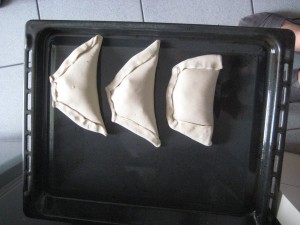 The finished empanadas were placed on a greased pan and brushed with egg. These were then baked in the oven until the crust was golden brown.
The finished empanadas were placed on a greased pan and brushed with egg. These were then baked in the oven until the crust was golden brown.
For the fried version, the edge of the semicircle was pinched into a wave like ruffle.
To fry the empanadas, my host mother heated a large wok with a deep pool of vegetable oil. She fried the empanadas two at a time turning them once when the bottom side was golden brown.
When evenly brown, she fished them out with a sieve and allowed them to rest on a paper towel before serving.
Enjoy!
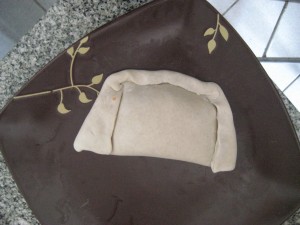


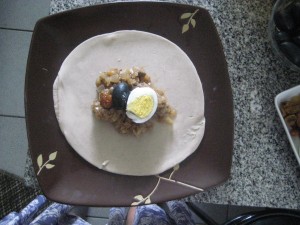
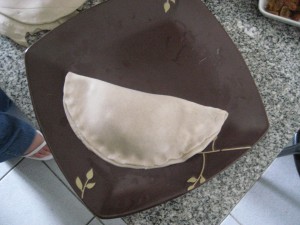
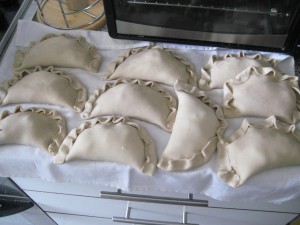
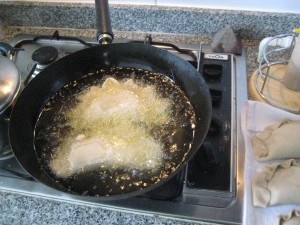
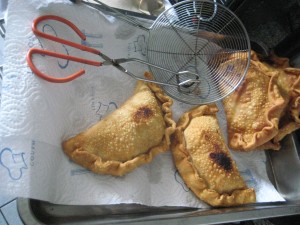
Kate said
Yummmmmmmm…..Empanadas! Let’s make them at Christmas (sans raisin of course)
kimberlygibson said
It is only 1 single ity-bity raisin that they put in each one, so they are easy to pick out! but we could do some without if you felt strongly about potential contamination 🙂